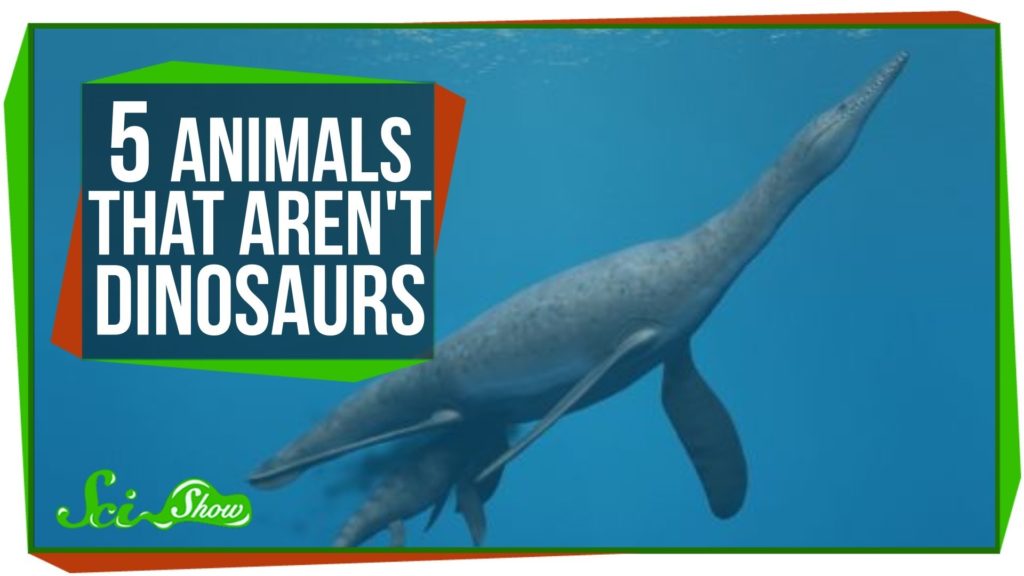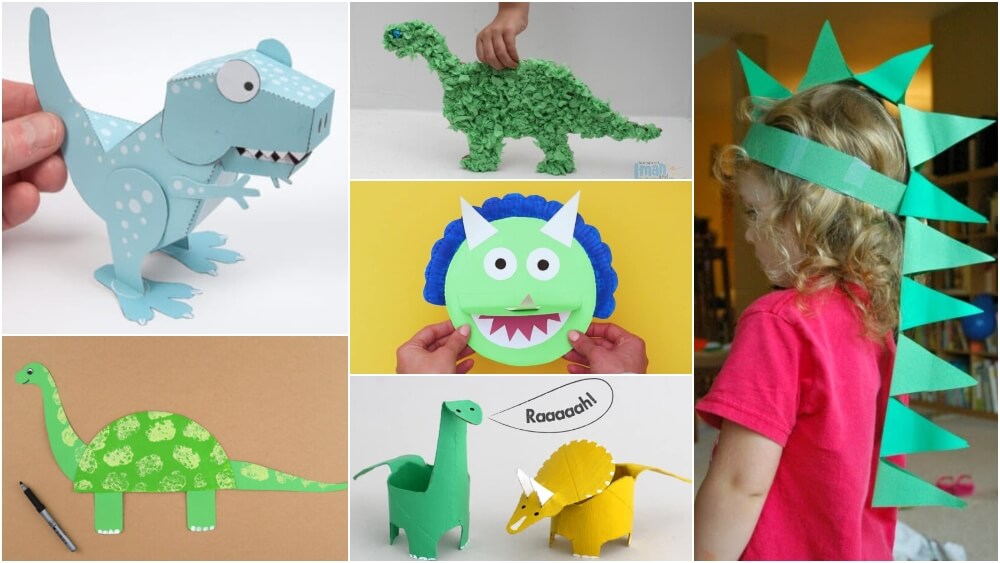5 Animals That Aren’t Dinosaurs

ize of giraffes … that could fly. When we started discovering fossils of animals like these hundreds of years ago, we lumped them together in our textbooks. By the mid 1800s, we had a word for them: “dinosaurs,” Greek for “terrible lizards.” And for a long time, anything that was weird and extinct and vaguely reptilian was called a dinosaur — even though scientists were finding that they actually weren’t that closely related to each other. We don’t classify organisms by how they look or behave — by that logic, bats and birds would be in the same group. Instead, we organize them by their evolutionary relationships
. And scientists have been teasing out those relationships for centuries by studying the only evidence we have left for dinosaurs: their bones. What we’re finding out is that a lot of the creatures that people still call dinosaurs are not that closely related to each other; they’re not actually that closely related to dinosaurs. Today, we know that the true, extinct dinosaurs were technically reptilian, in that they laid eggs and lived on land.
Beyond that, paleontologists identify dinosaurs by looking for specific skeletal traits, particularly in their heads and their legs. In the head, all dinosaurs have four distinct holes in their skull bones — two little windows on each side of their faces, right behind the eye. Those holes allowed dinosaurs’ skulls to grow larger without getting too much heavier, and made possible the big, powerful jaws that many became known for. Animals with these skull holes are called diapsids, meaning “two arches,” and they include many of today’s reptiles, as well as birds. Now check out the legs. Most reptiles, like alligators and lizards, walk with their legs out to the sides. Their thigh bones run parallel to the ground, and they move by scuttling forward. Dinosaurs’ legs did not do that. They had hips that allowed their legs to go directly out from under their bodies.
So they walked with upright limbs below them, just like modern birds continue to do. Once you put all these things together, it becomes a little easier to figure out who the dinosaurs were, and who they weren’t. For instance, one of the more infamous dinosaur impostors is Dimetrodon, a genus of distinctive, reptilian-looking animals that lived about 300 million years ago. Going by appearances, these guys generally fit the exotic, popular conception of dinosaurs — giant lizards with fearsome teeth and freaky sails erupting from their backs. Like, if they came in to read for Jurassic Park 5, they would probably get the part.
But Dimetrodon lived hundreds of millions of years before dinosaurs came on the scene, and even though they looked like giant hunchbacked iguanas, they’re actually more closely related to us than they are to dinosaurs. Yup! Dimetrodon is an important, but lesser known, character in our family tree. They’re sometimes described as a “mammal-like reptiles,” but they’re not true reptiles, even though they laid eggs and were mostly scaly. Instead, they’re synapsids. Unlike diapsids, with the two skull holes on each side, synapsids have only one little window just behind each eye socket. And you have one, too, right here above where your jaw hinges.
That’s because you, and all of the other mammals alive today, are the only living synapsids. Critters like Dimetrodon are the distant evolutionary ancestors of us; and in fact its flamboyant back-sail-thing is actually one of the earliest signs of their connection to us. Paleontologists think it was a fleshy flap full of blood vessels that allowed it to regulate its body temperature — something truly cold-blooded reptiles could never do. And look at how it stands — its legs are out there on the side, like a crocodile, not underneath, like a T. rex or a stegosaurus. All right then what about the pterosaurs? They could fly, and birds can fly, so pterosaurs must be some kind of dinosaur, right?
Nup. Pterosaurs were reptiles that just happened to arrive at the same mode of travel that birds, bats, yellow jackets, and lots of other animals did: flight. Named “winged lizards” in Greek, pterosaurs ruled the skies from 230 to 66 million years ago, and we can tell from their hollow bones and their musculature that they really could fly. The earlier and more primitive, or basal, pterosaurs found in the fossil record had long tails that probably helped them with this new thing called flying. But later pterosaurs with specialized, or derived, features, had much shorter tails, and these are the guys that most of us associate with this group of animals. They’re the pterodactyloids, or “winged fingers,” and since they were the first to be discovered, for a long time, many people mistakenly used the word “pterodactyl” to describe all the flying reptiles.
Pteranodon is one of the better-known pterodactyloids, with the tapered wings and crested heads that you’ve probably seen either in museums, or in vintage cartoons — depending on how you prefer to get your information. And one of the last of the pterosaurs ever to take wing was a truly amazing creature, Quetzalcoatlus, a flying reptile that stood as tall as a giraffe and whose wings spread up to 12 meters. Even though it lived 70 million years ago, it remains the largest animal that ever flew. Now, pterosaurs lived alongside — or rather above — the dinosaurs, and they’re probably more closely related to the dinosaurs than any of the other animals that are mistaken for them. But they couldn’t walk upright like dinosaurs did, and scientists think that they diverged into their own branch of the reptile family tree, while dinosaurs went on to diversify. So what about the sea?
A lot of what is now dry land was once covered with water, and we’ve been finding fossils of aquatic animals for hundreds of years. So aren’t any of those dinosaurs? Let me stop you right there. In addition to the four-holes-in-the-skull thing and the legs-under-its-body thing, we also know that dinosaurs only lived on land. Period. So anything that swam wasn’t a dinosaur. Instead, those marine reptiles were part of an evolutionary offshoot from the dinosaur line, which led to modern lizards.
These seafarers actually evolved from land-based reptiles, and you can see it in their sprawling, lizard-like posture. Plesiosaurs, for example, were aquatic animals with tiny heads at the end of really long necks. And with the water to buoy them up, they were able to grow stupendously large — up to 17 meters long — and they left behind the bones to prove it. The first fossilized one was found in England in 1821, and scientists at the time didn’t know what to make of it. So they named it Plesiosaurus, meaning “almost lizard.” But plesiosaurs also include the pliosaurs, which were smaller, and had shorter necks and huge, toothy jaws. These guys were the top predators of the ancient oceans, hunting sharks, bony fish, probably even taking out their own kind.
But what makes plesiosaurs extra fascinating is that they gave birth to live young, like only a very few snakes and lizards do today, instead of laying eggs. In fact, those fossil plesiosaurs have been found with fetuses still in the womb. And just to remind you how weird ancient reptiles were, and how bad scientists are at naming things, there are also the icthyosaurs. If you remember enough Greek from biology, you probably know their name means “fish lizard,” even though of course they weren’t remotely related to fish. But unlike plesiosaurs — with their four giant flippers — ichthyosaurs did look a lot like fish. Some had vertical fins on their tails and backs, for instance, and larger pectoral fins in front for propulsion. But they couldn’t breathe the water.
They had to swim to the surface for air, and they too gave birth to live young. Icthyosaurs shared the seas with plesiosaurs and other marine creatures starting about 250 million years ago. And they probably gave everyone a run for their money, until the last of them vanished abruptly about 90 million years ago. So what’s left? Well, on land, dinosaurs had another good 25 million years left. So horned herbivores like Triceratops were grazing what’s now the American West; four-legged carnivores were prowling Madagascar, and giant sauropods were making the ground shake in Argentina.
But back in the ocean, the mosasaurs had arisen, and they pretty much had the pool to themselves. When cable TV does those animated shows about “sea monsters,” these are the creatures they’re often talking about. Their closest evolutionary descendants today are snakes — with whom they likely share a close common ancestor — and like snakes they had double-hinged jaws that opened wide enough to let them swallow prey bigger than their own heads. Because of this, we know a lot about what mosasaurs ate, because we keep finding all kinds of stuff inside their fossilized stomachs.
And they ate pretty much everybody, including animals we recognize today, like seabirds, bony fish, sharks — even the whole skeletons of other mosasaurs have been found inside mosasaurs. And even though they reached lengths up to 17 meters, they swam just like really big sea snakes, really big, terrifying sea snakes. So, now that you know a little more about these cases of prehistoric mistaken identity, you can see why those things are not dinosaurs. Some were more closely related to lizards, or snakes, or even mammals, than to the animals with that unique combination of traits that we identify with true dinos. But then of course we all know this story: 65 million years ago, something terrible happened to them.
The dinosaurs, along with the pterosaurs, the mosasaurs and the last of the plesiosaurs, very quickly went extinct. It’s known as the Cretaceous-Paleogene extinction event, and it was the second biggest wipe-out in all of the Earth’s history. What we think caused it is a conversation for another time, but for now let’s just focus on the upside! Birds — with their diapsid skulls and vertical posture — survived, making them the last of the true dinosaurs. And so did the mammals, which makes us, and our mammalian kin, the only remaining synapsids on Earth.
It can be a burden sometimes, being the ones that were left behind. Seems like the least we can do is remember the dinosaurs. And I mean that, like, literally — let’s do our best to remember who the dinosaurs were, and who they were not.






Responses